英语基础语法(免费)
- 格式:doc
- 大小:101.00 KB
- 文档页数:10
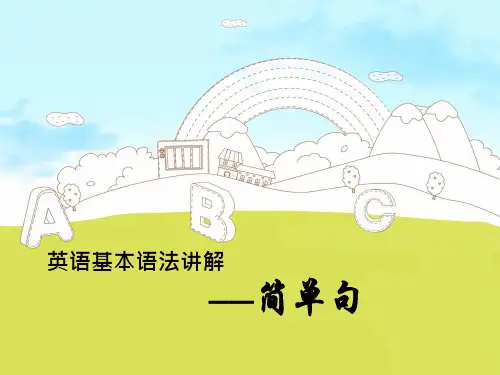
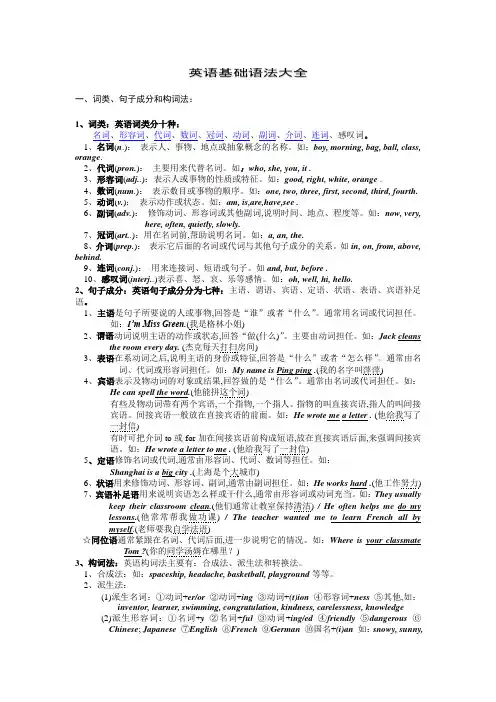
英语基础语法大全一、词类、句子成分和构词法:1、词类:英语词类分十种:名词、形容词、代词、数词、冠词、动词、副词、介词、连词、感叹词。
1、名词(n.):表示人、事物、地点或抽象概念的名称。
如:boy, morning, bag, ball, class, orange.2、代词(pron.):主要用来代替名词。
如:who, she, you, it .3、形容词(adj..):表示人或事物的性质或特征。
如:good, right, white, orange .4、数词(num.):表示数目或事物的顺序。
如:one, two, three, first, second, third, fourth.5、动词(v.):表示动作或状态。
如:am, is,are,have,see .6、副词(adv.):修饰动词、形容词或其他副词,说明时间、地点、程度等。
如:now, very,here, often, quietly, slowly.7、冠词(art..):用在名词前,帮助说明名词。
如:a, an, the.8、介词(prep.):表示它后面的名词或代词与其他句子成分的关系。
如in, on, from, above, behind.9、连词(conj.):用来连接词、短语或句子。
如and, but, before .10、感叹词(interj..)表示喜、怒、哀、乐等感情。
如:oh, well, hi, hello.2、句子成分:英语句子成分分为七种:主语、谓语、宾语、定语、状语、表语、宾语补足语。
1、主语是句子所要说的人或事物,回答是“谁”或者“什么”。
通常用名词或代词担任。
如:I’m Miss Green.(我是格林小姐)2、谓语动词说明主语的动作或状态,回答“做(什么)”。
主要由动词担任。
如:Jack cleansthe room every day. (杰克每天打扫房间)3、表语在系动词之后,说明主语的身份或特征,回答是“什么”或者“怎么样”。
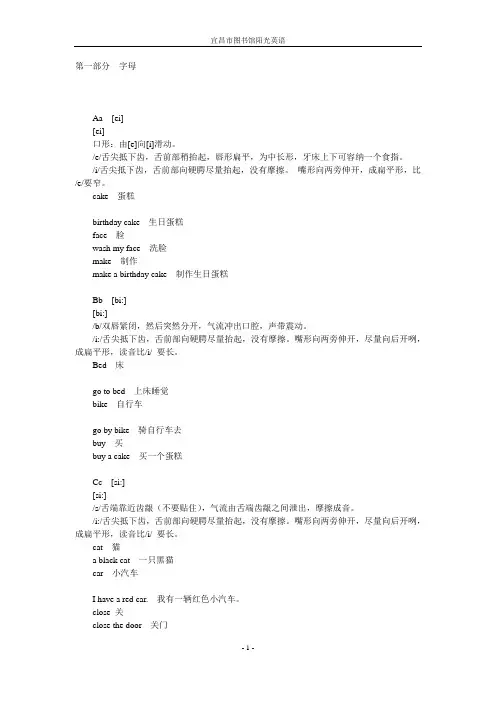
第一部分字母Aa[ei][ei]口形:由[e]向[i]滑动。
/e/舌尖抵下齿,舌前部稍抬起,唇形扁平,为中长形,牙床上下可容纳一个食指。
/i/舌尖抵下齿,舌前部向硬腭尽量抬起,没有摩擦。
嘴形向两旁伸开,成扁平形,比/e/要窄。
cake蛋糕birthday cake生日蛋糕face脸wash my face洗脸make制作make a birthday cake制作生日蛋糕Bb[bi:][bi:]/b/双唇紧闭,然后突然分开,气流冲出口腔,声带震动。
/i:/舌尖抵下齿,舌前部向硬腭尽量抬起,没有摩擦。
嘴形向两旁伸开,尽量向后开咧,成扁平形,读音比/i/ 要长。
Bed床go to bed上床睡觉bike自行车go by bike骑自行车去buy买buy a cake买一个蛋糕Cc[si:][si:]/s/舌端靠近齿龈(不要贴住),气流由舌端齿龈之间泄出,摩擦成音。
/i:/舌尖抵下齿,舌前部向硬腭尽量抬起,没有摩擦。
嘴形向两旁伸开,尽量向后开咧,成扁平形,读音比/i/ 要长。
cat猫a black cat一只黑猫car小汽车I have a red car.我有一辆红色小汽车。
close 关close the door关门come来Dd[di:][di:]/d/舌尖紧贴上齿龈,形成阻碍,然后突然下降,气流冲出口腔,声带要振动。
/i:/舌尖抵下齿,舌前部向硬腭尽量抬起,没有摩擦。
嘴形向两旁伸开,尽量向后开咧,成扁平形,读音比/i/ 要长。
door门open/close the door开/关门dog狗a little dog一只小狗Ee[i:]/i:/舌尖抵下齿,舌前部向硬腭尽量抬起,没有摩擦。
嘴形向两旁伸开,尽量向后开咧,成扁平形,读音比/i/ 要长。
Teeth牙齿brush my/your teeth刷牙bee蜜蜂as busy as a bee忙忙碌碌,极其忙碌teach教teach English教英语Ff[ef][ef]/e/舌尖抵下齿,舌前部稍抬起,唇形扁平,为中长形,牙床上下可容纳一个食指。
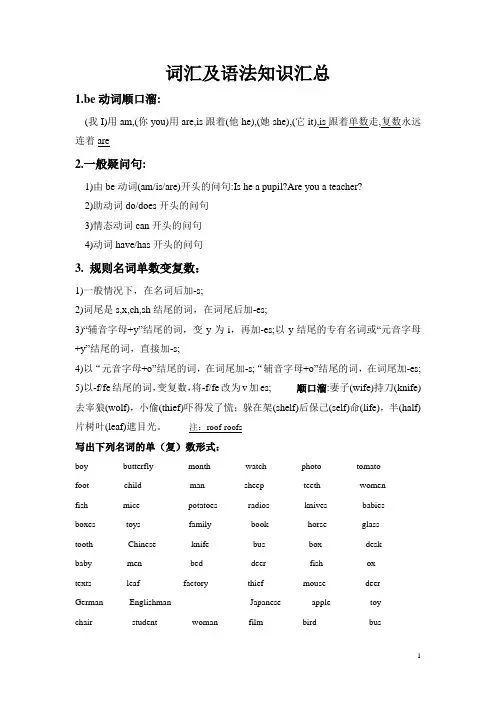
词汇及语法知识汇总1.be动词顺口溜:(我I)用am,(你you)用are,is跟着(他he),(她she),(它it),is跟着单数走,复数永远连着are2.一般疑问句:1)由be动词(am/is/are)开头的问句:Is he a pupil?Are you a teacher?2)助动词do/does开头的问句3)情态动词can开头的问句4)动词have/has开头的问句3. 规则名词单数变复数:1)一般情况下,在名词后加-s;2)词尾是s,x,ch,sh结尾的词,在词尾后加-es;3)“辅音字母+y”结尾的词,变y为i,再加-es;以y结尾的专有名词或“元音字母+y”结尾的词,直接加-s;4)以“元音字母+o”结尾的词,在词尾加-s;“辅音字母+o”结尾的词,在词尾加-es;5)以-f/fe结尾的词,变复数,将-f/fe改为v加es; 顺口溜:妻子(wife)持刀(knife)去宰狼(wolf),小偷(thief)吓得发了慌;躲在架(shelf)后保己(self)命(life),半(half)片树叶(leaf)遮目光。
注:roof-roofs写出下列名词的单(复)数形式:boy________butterfly________month________watch________photo________tomato_________ foot________child___________man_________sheep_________teeth_________women________ fish________mice___________potatoes_______radios________knives________babies________ boxes_______toys___________family_________book_________horse________glass_________ tooth________Chinese________knife__________bus__________box__________desk________ baby________men___________bed___________deer__________fish__________ox__________ texts________leaf__________factory_________thief_________mouse_________deer________ German______Englishman__________________Japanese_______apple_________toy_________ chair_________student________woman_______film_________bird____________bus_________map__________hero__________dish__________class________radio____________church_____ party______4.一般疑问句的否定结构:把not放在一般疑问句的主语之后,即构成一般疑问句的否定结构.eg.Is she not a student?eg.Have you not any sisters?eg.Can she not do it?5.陈述句转疑问句及回答:This is a watch.- Is this a watch?Yes,it is(不许缩写).No,it isn’t(必须缩写).6.陈述句变否定句:This is a watch.→This is not(isn’t) a watch.7.主要字母组合的发音8.几个发音特殊的辅音字母A.字母c在a,l,o,r,u等前读[k],如come[k ʌm],coat[k əut] 等.字母c在e,I,y前读[s],如pencil[pensl]等B.字母g一般读[g],如go[gəu],leg[leg]等,字母g和e(即ge)在词尾读[dʒ],如orange[ɔrindʒ]等C.双写辅音字母虽然是两个相同的辅音字母写在一起,但只读一个音,如apple[æpl]egg[eg]等。
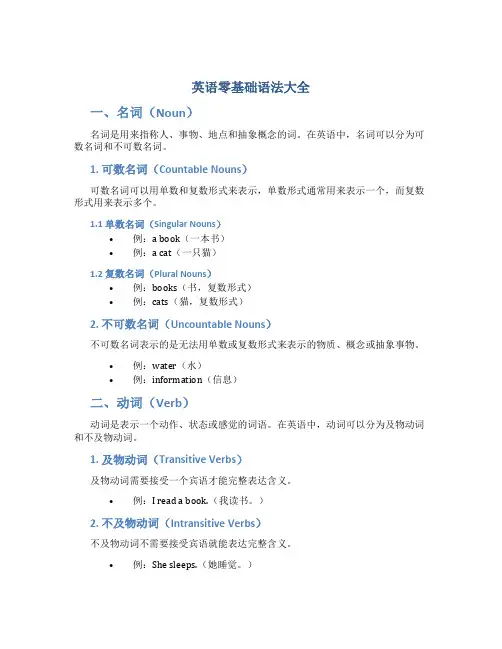
英语零基础语法大全一、名词(Noun)名词是用来指称人、事物、地点和抽象概念的词。
在英语中,名词可以分为可数名词和不可数名词。
1. 可数名词(Countable Nouns)可数名词可以用单数和复数形式来表示,单数形式通常用来表示一个,而复数形式用来表示多个。
1.1 单数名词(Singular Nouns)•例:a book(一本书)•例:a cat(一只猫)1.2 复数名词(Plural Nouns)•例:books(书,复数形式)•例:cats(猫,复数形式)2. 不可数名词(Uncountable Nouns)不可数名词表示的是无法用单数或复数形式来表示的物质、概念或抽象事物。
•例:water(水)•例:information(信息)二、动词(Verb)动词是表示一个动作、状态或感觉的词语。
在英语中,动词可以分为及物动词和不及物动词。
1. 及物动词(Transitive Verbs)及物动词需要接受一个宾语才能完整表达含义。
•例:I read a book.(我读书。
)2. 不及物动词(Intransitive Verbs)不及物动词不需要接受宾语就能表达完整含义。
•例:She sleeps.(她睡觉。
)三、形容词(Adjective)形容词用来描述名词或代词的特征或性质。
•例:a beautiful flower(一朵美丽的花)四、副词(Adverb)副词用来修饰动词、形容词或其他副词,表示时间、位置、原因等信息。
•例:She sings beautifully.(她唱得很美。
)五、代词(Pronoun)代词用来代替名词,帮助避免重复使用名词。
•例:He is my brother. He is very kind.(他是我的兄弟。
他非常友好。
)六、冠词(Article)冠词分为定冠词“the”和不定冠词“a”、“an”,用来限定名词的范围或特定性质。
•例:I have a cat. The cat is black.(我有一只猫。
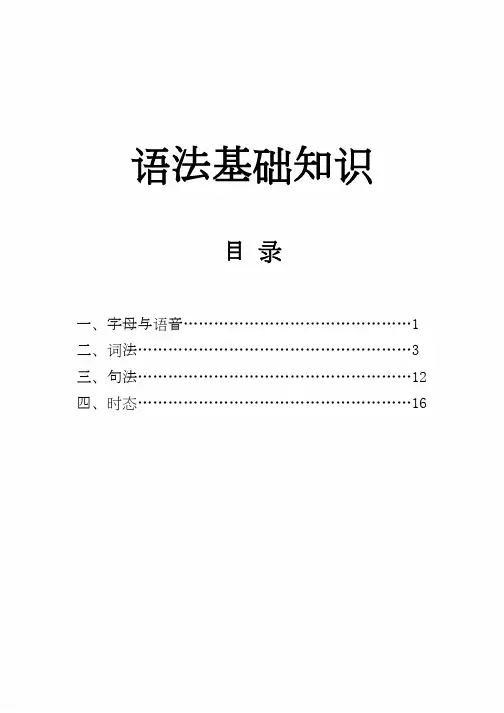
语法基础知识目录一、字母与语音 (1)二、词法 (3)三、句法 (12)四、时态 (16)语法基础知识一、字母与语音ɔ 主要字母组合的发音字母组合发音例词aralcar,bar,far,star small [a:][ɔ:]ayea play [ei][i :][ei]tea,beat,read,eat break,great bread [e]eeei[i :][ei]bee,see,Lee,jeep eight oo[u ]cook,foot,look,classroom boot,food,gooes,room coat,boat,goat oil [u :]oaoiu [ə ]ɔ[ i ]ir:[ə ]bird ooroyow[ :]door ɔɔ[ i ]boy [au ][ əu ][au ]how Know ouor house [ə:][ə]work,world,worse doctor,visitor,tractor morning [ɔ:]er[ə]sister,brother,mother,father her,term [ə:]irəbird,shirt,third,girl beer,deer,cheer turn [ :][ ə]eeruri [ə:][e ə]eirereeartheir [εə][i ə]there,where hear,fear [εə][εə][θ][ð]pear,bear,wear chair,hair airththree,thirty,thin,thousand this,those,these,they chick,click,cock,clockck [k ]0给大家推荐一个英语微信群Empty Your Cup英语微信群是目前学习英语最有效的方法,群里都是说英语,没有半个中文,而且规则非常严格,是一个超级不错的英语学习环境,群里有好多英语超好的超牛逼的人,还有鬼佬和外国美眉。
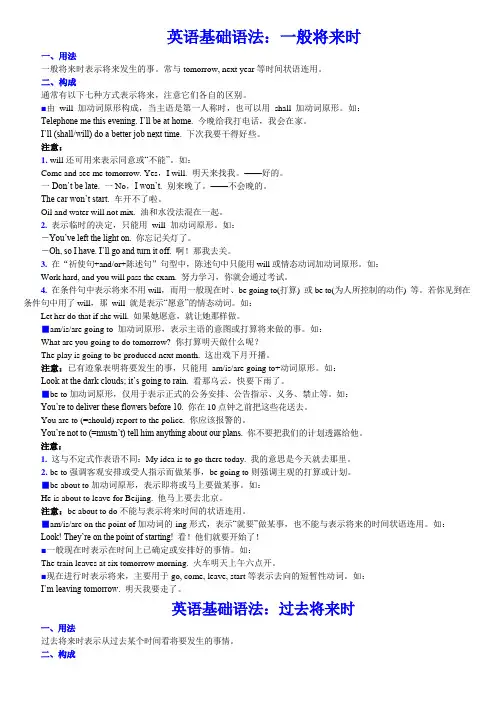
英语基础语法:一般将来时一、用法一般将来时表示将来发生的事。
常与tomorrow, next year等时间状语连用。
二、构成通常有以下七种方式表示将来,注意它们各自的区别。
■由will 加动词原形构成,当主语是第一人称时,也可以用shall 加动词原形。
如:Telephone me this evening. I’ll be at home. 今晚给我打电话,我会在家。
I’ll (shall/will) do a better job next time. 下次我要干得好些。
注意:1. will还可用来表示同意或“不能”。
如:Come and see me tomorrow. Yes,I will. 明天来找我。
——好的。
一Don’t be late. 一No,I won’t. 别来晚了。
——不会晚的。
The car won’t start. 车开不了啦。
Oil and water will not mix. 油和水没法混在一起。
2. 表示临时的决定,只能用will 加动词原形。
如:-You’ve left the light on. 你忘记关灯了。
-Oh, so I have. I’ll go and turn it off. 啊!那我去关。
3. 在“祈使句+and/or+陈述句”句型中,陈述句中只能用will或情态动词加动词原形。
如:Work hard, and you will pass the exam. 努力学习,你就会通过考试。
4. 在条件句中表示将来不用will,而用一般现在时、be going to(打算) 或be to(为人所控制的动作) 等。
若你见到在条件句中用了will,那will 就是表示“愿意”的情态动词。
如:Let her do that if she will. 如果她愿意,就让她那样做。
■am/is/are going to 加动词原形,表示主语的意图或打算将来做的事。
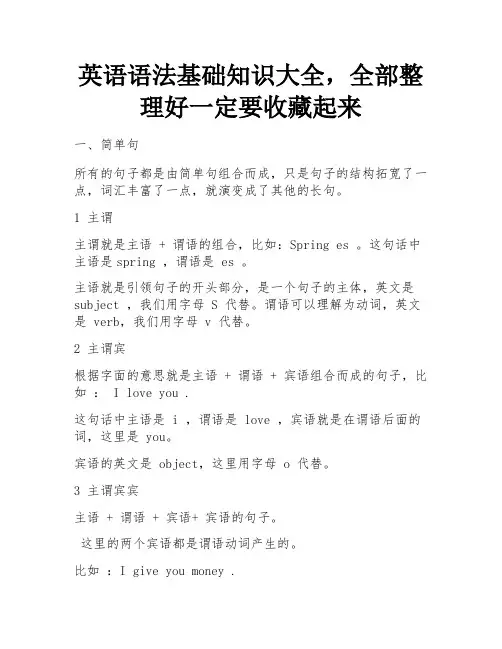
英语语法基础知识大全,全部整理好一定要收藏起来一、简单句所有的句子都是由简单句组合而成,只是句子的结构拓宽了一点,词汇丰富了一点,就演变成了其他的长句。
1 主谓主谓就是主语 + 谓语的组合,比如:Spring es 。
这句话中主语是spring ,谓语是 es 。
主语就是引领句子的开头部分,是一个句子的主体,英文是subject ,我们用字母 S 代替。
谓语可以理解为动词,英文是 verb,我们用字母 v 代替。
2 主谓宾根据字面的意思就是主语 + 谓语 + 宾语组合而成的句子,比如: I love you .这句话中主语是 i ,谓语是 love ,宾语就是在谓语后面的词,这里是 you。
宾语的英文是 object,这里用字母 o 代替。
3 主谓宾宾主语 + 谓语 + 宾语+ 宾语的句子。
这里的两个宾语都是谓语动词产生的。
比如:I give you money .这里的 you 和 money 都是 give 的宾语,give you 和 give money ,所以都是两个宾语。
4 主谓宾宾补主语 + 谓语 + 宾语+ 宾补的句子。
比如:It makes me happy .这里的 me 是 make 的宾语,但是 happy 不是 make 的宾语。
happy 是 me 的形容词,是一个宾补,全称为宾语补足语,起到了补充说明的作用。
注意:区分主谓宾宾和主谓宾宾补主谓宾中的两个宾语都是谓语产生的动作词,而主谓宾补语是宾语的形容词,与谓语无关。
5 主系表这里,系统代表系动词。
包含三个类别A be 动词: am is are was wereB 感官动词(五官)look 看起来sound 听起来smell 闻起来taste 尝起来feel 摸着....感觉......C 变化动词bee / turn / go / get / grow这里的表是代表表语,包括名词、形容词、介宾短语、不定式todo比如 you are beautiful 这句话中,you 是主语,are 是系动词,beautiful 是表语。
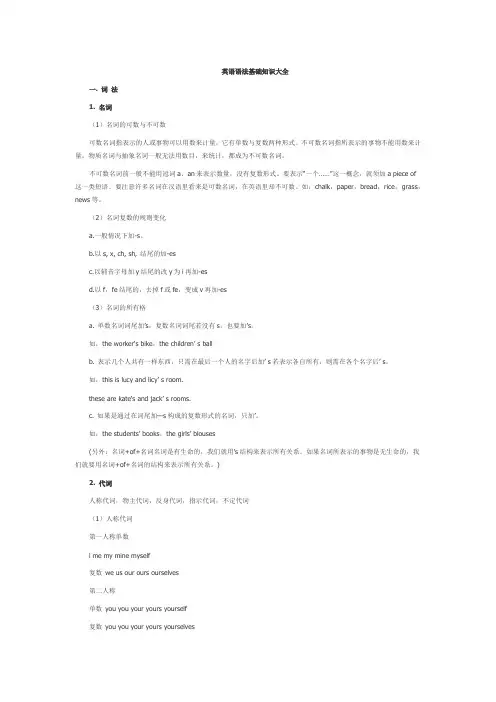
英语语法基础知识大全一. 词法1. 名词(1)名词的可数与不可数可数名词指表示的人或事物可以用数来计量,它有单数与复数两种形式。
不可数名词指所表示的事物不能用数来计量。
物质名词与抽象名词一般无法用数目,来统计,都成为不可数名词。
不可数名词前一般不能用冠词a、an来表示数量,没有复数形式。
要表示“一个……”这一概念,就须加a piece of这一类短语。
要注意许多名词在汉语里看来是可数名词,在英语里却不可数。
如:chalk,paper,bread,rice,grass,news等。
(2)名词复数的规则变化a.一般情况下加-s。
b.以s, x, ch, sh, 结尾的加-esc.以辅音字母加y结尾的改y为i再加-esd.以f,fe结尾的,去掉f或fe,变成v再加-es(3)名词的所有格a. 单数名词词尾加’s,复数名词词尾若没有s,也要加’s。
如:the worker‘s bike,the children’ s ballb. 表示几个人共有一样东西,只需在最后一个人的名字后加’ s若表示各自所有,则需在各个名字后’ s。
如:this is lucy and licy’ s room.these are kate‘s and jack’ s rooms.c. 如果是通过在词尾加—s构成的复数形式的名词,只加’。
如:the students’ books,the girls’ blouses(另外:名词+of+名词名词是有生命的,我们就用’s结构来表示所有关系。
如果名词所表示的事物是无生命的,我们就要用名词+of+名词的结构来表示所有关系。
)2. 代词人称代词,物主代词,反身代词,指示代词,不定代词(1)人称代词第一人称单数i me my mine myself复数 we us our ours ourselves第二人称单数you you your yours yourself复数you you your yours yourselves第三人称单数he him his his himselfshe her her hers herselfit it its its itself复数they them their theirs themselves(2)物主代词物主代词的用法:形容词性物主代词后面一定要跟上一个名词;名词性物主代词可作主语、表语、宾语。
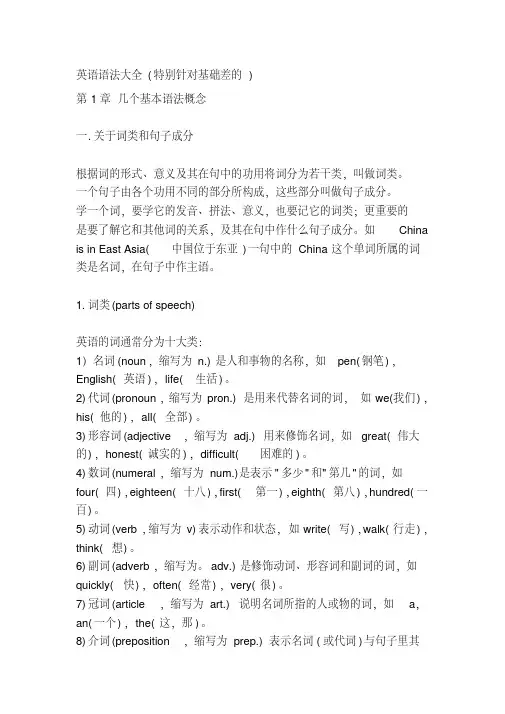
英语语法大全(特别针对基础差的)第1章几个基本语法概念一.关于词类和句子成分根据词的形式、意义及其在句中的功用将词分为若干类,叫做词类。
一个句子由各个功用不同的部分所构成,这些部分叫做句子成分。
学一个词,要学它的发音、拼法、意义,也要记它的词类;更重要的是要了解它和其他词的关系,及其在句中作什么句子成分。
如China is in East Asia(中国位于东亚)一句中的China这个单词所属的词类是名词,在句子中作主语。
1.词类(parts of speech)英语的词通常分为十大类:1)名词(noun,缩写为n.)是人和事物的名称,如pen(钢笔),English(英语),life(生活)。
2)代词(pronoun,缩写为pron.)是用来代替名词的词,如we(我们),his(他的),all(全部)。
3)形容词(adjective,缩写为adj.)用来修饰名词,如great(伟大的),honest(诚实的),difficult(困难的)。
4)数词(numeral,缩写为num.)是表示"多少"和"第几"的词,如four(四),eighteen(十八),first(第一),eighth(第八),hundred(一百)。
5)动词(verb,缩写为v)表示动作和状态,如write(写),walk(行走),think(想)。
6)副词(adverb,缩写为。
adv.)是修饰动词、形容词和副词的词,如quickly(快),often(经常),very(很)。
7)冠词(article,缩写为art.)说明名词所指的人或物的词,如a,an(一个),the(这,那)。
8)介词(preposition,缩写为prep.)表示名词(或代词)与句子里其它词的关系,如from(从),in(在…内),between(在…之间)。
9)连词(conjunction,缩写为conj.)是连接词、短语、从句和句子的词,如and(和),because(因为),if(假如)。
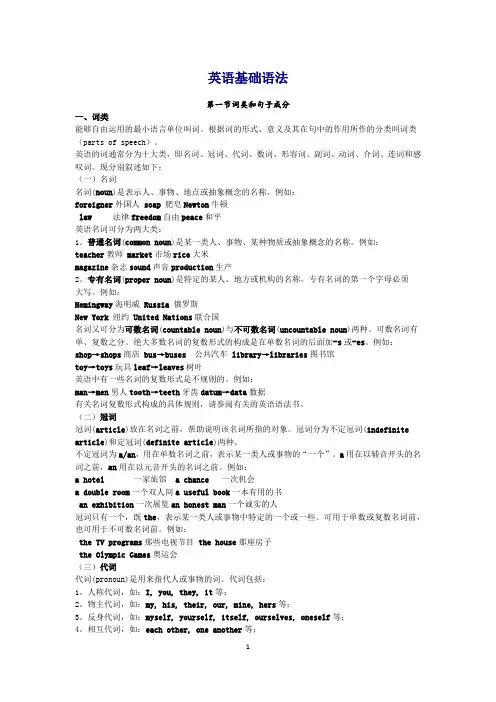
英语基础语法第一节词类和句子成分一、词类能够自由运用的最小语言单位叫词。
根据词的形式、意义及其在句中的作用所作的分类叫词类(parts of speech)。
英语的词通常分为十大类,即名词、冠词、代词、数词、形容词、副词、动词、介词、连词和感叹词。
现分别叙述如下:(一)名词名词(noun)是表示人、事物、地点或抽象概念的名称。
例如:foreigner外国人 soap 肥皂Newton牛顿law 法律freedom自由peace和平英语名词可分为两大类:1。
普通名词(common noun)是某一类人、事物、某种物质或抽象概念的名称。
例如:teacher教师 market市场rice大米magazine杂志sound声音production生产2。
专有名词(proper noun)是特定的某人、地方或机构的名称。
专有名词的第一个字母必须大写。
例如:Hemingway海明威 Russia 俄罗斯New York 纽约 United Nations联合国名词又可分为可数名词(countable noun)与不可数名词(uncountable noun)两种。
可数名词有单、复数之分。
绝大多数名词的复数形式的构成是在单数名词的后面加-s或-es。
例如:shop→shops商店 bus→buses 公共汽车 library→libraries图书馆toy→toys玩具leaf→leaves树叶英语中有一些名词的复数形式是不规则的。
例如:man→men男人tooth→teeth牙齿datum→data数据有关名词复数形式构成的具体规则,请参阅有关的英语语法书。
(二)冠词冠词(article)放在名词之前,帮助说明该名词所指的对象。
冠词分为不定冠词(indefinite article)和定冠词(definite article)两种。
不定冠词为a/an,用在单数名词之前,表示某一类人或事物的“一个”。
a用在以辅音开头的名词之前,an用在以元音开头的名词之前。
一.26个大小写字母大写:A B C D E F G H I J K L M N 小写:a b c d e f g h i j k l m n 大写:O P Q R S T U V W X Y Z小写:o p q r s t u v w x y z二.10种单词词性动词名词形容词冠词副词数词介词感叹词连词代词三.8种句子成分主语谓语宾语表语定语状语宾补同位语四.16种时态公式1.一般现在时do2.一般过去时did2.一般将来时will do 4.过去将来时would do5.现在进行时be doing6.将来进行时will be doing6.现在完成时have/has done 8.过去进行was/were doing 9.过去完成时had done 10.将来完成时will have done11.过去将来进行would be doing12.过去将来完成would have done13.现在完成进行have been doing14.过去完成进行had been doing15.将来完成进行时 will have been doing16.过去将来完成进行时 would have been doing五.4大特殊句式1. There be结构2.It is….that强调句(定语从句)3.倒装句4.省略句六.20个疑问代词问谁who 问什么 what 问年龄 how old 问原因 why 问多少how many 问哪里where 问价格how much问哪个which 问多高how tall 问多大how big问谁的whose 问多长 how long 问颜色what color问多久一次how often 问几点what time 问多久how soon 问星期what day 问多重how heavy 问时候 when七.8种句子结构主+谓主+谓+宾主+系+表主+谓+宾宾主+谓+宾+宾补名词性从句形容词性从句(定语从句)副词性从句(状语从句)八.8组人称代词I 我 (主格) me 我(宾格) my 我的you 你 (主格) you 你 (宾格) your 你的he 他 (主格) him 他(宾格) his 他的she 她 (主格) her 她(宾格) hers 她的we 我们 (主格) us 我们(宾格) our 我们的they 他们(主格) them 他们 (宾格) their 他们的it 它 (主格) it 它 (宾格) its 它的that 那,那个 these 这些 those 那些九.8组英语时态一般现在时 do/does am/is are一般将来时 will do will/shall be done一般过去时 did was/were done现在进行时 be doing am/is/are being doing现在完成时 have/has done have/has been done过去完成时 had done had been done过去将来时 would do would be done过去进行时 be doing was/were being done十.26组英语缩略词I am -I’m is not -isn’t It is -it’s are not -aren’t They are -they’re did not -didn’t What is 一what’s I will -I’ll When is -when’swe will -we’ll Who is -who’s will not -won’t He is -he’s was not -wasn’t She is -She’s were not -weren’t That is -that’s can not -can’t There is -there’s You are -you’re could not -couldn’t do not -don’t We are -we’re does not -doesn’t This is- / where is -where’s十一.10大词性1.名词 Noun1) 表示人、事物、地点等世间万物的名称2) 例如:Apple、China、pen3) 主要语法:名词单复数、名词所有格、主谓一致、变化规则等2.动词 Verb1) 表示动作或状态2) 例如: smile、alleviate、finish、attempt3) 主要语法:be动词、情态动词、助动词、系动词、被动语态等3.副词 Adverbs1)说明时间、地点、程度、方式等概念的词;修饰动词或形容词2) 例如: remarkably、frequently、significantly3) 主要语法:时间副词、地点副词、方式副词、关系副词等4.形容词 Adjective1) 表示人或事物的性质、状态或特征;修饰名词或代词adj+n2) 例如: remarkable、international、undesirable3) 主要语法:比较级、最高级、做定语、表语或宾语补足语等5.数词 Numeral1) 表示数量或顺序2) 例如: one、first、twenty-two3) 主要语法:序数词、基数词、日期的表达、数词的表达等6.代词 Pronoun1)替代人或事物2)例如: we、it、myself、them、this3)主要语法:不定代词、人称代词、物主代词、疑问代词等7.连词 Conjunction1) 用来连接句子、短语和词语2) 例如: and、but、so、however、either or3) 主要语法:从属连词、并列连词8.感叹词 Interjection1) 表示情感变化2) 例如: oh! opps、bravo3) 主要语法:独立于句子之外9.介词 Preposition1) 表示名词或代词和其他词的关系2) 例如:in、on、about、by、after3) 主要语法: 地点介词、方向介词、时间介词、介词短语等10.冠词 Article1) 限定名词的意义;用于名词之前2) 例如: a、an、the (仅此三个)3) 主要语法:定冠词(the)、不定冠词(a、an) 、零冠词十二.8大时态标志词①「一般现在时」l.always 总是 ually 通常 3.often 经常4.sometimes 有时 5.never 从不 6.every day每天7.every time 每次 8.in the morning 早上9.once a week 每周一次 10.three times a week 每周三次11.twice a month 每月两次 12.hardly ever 几乎不13.every Sunday 每个周日 14.at night 在晚上②「一般过去时」1.ago以前2.yesterday昨天3.the day before yesterday前天st night昨晚st time上次st year去年st term上学期 st Monday上周一9.once upon a time 曾经 10.once 曾经 11.just now刚才12.in+过去的时间过去某时 13.in the early days 在早期③「一般将来时」l.tomorrow 明天 2.the day after tomorrow 后天3.tomorrow night 明晚 4.next time 下次5.next Friday 下周五6.next month 下个月7.next term 下学期 8.in+一段时间多久之后9.soon 很快 10.sooner or later 迟早11.at once 立刻 12.by the end of+将来时间④「现在进行时」l.now 现在 2.look 看 3.listen 听4.at this time 此时5.at this moment 此时6.at present 现在7.right now 现在⑤「过去进行时」l.at that time 在那时 2.at that moment 在那时⑥「将来进行时」l.tomorrow 明天 2.the day after tomorrow 后天3.soon待会4.next week/month/ year /下个周/月1明年⑦「现在完成时」1.already 已经2.yet 还3.just 刚才4.never 从不5.ever 曾经6.before 以前7.up to now 目前为止8.so far 目前为止9.for+一段时间 10.since+过去某一时间⑧「过去完成时」1.by+过去时间点2.by the time 到..时候为止3.by then 到那时候4.by last time 最后一次5.by the end of last week 到了上周末6.before+过去时间点7.up until+过去时间点8.up until then 直到那时9.up until last time 直到上次十三.8种句子结构主+谓1) He runs.他跑。
英语语法基础知识第1课:1、be (是)动诃的用法:am接I; is接第三人称单数,即除you、I夕卜;are接表示多个人或事物,即复数。
(我是am,你是are, is连接它、她、他,单数is,复数are)。
2、not 是表示否定的词:不是的表达,am not, is not (isn' t), are not (£iren, t)a3、“一•个”和“几个”的问题:“一个”是a+名词;“多个”是名词后面加s。
4、以无音开头(如O、E等),前面的冠词用an。
第2课:1、及物动词与不及物动词的区别:及物动词后面接宾语;而不及物动词后面不接宾语。
女|[ I like ice cream , It hurts o2、主语是he、she、i(和单数名词时,动词要发生第三人称的变化,即加s。
3、否定的用法:在动词之询加do not或does not。
I、You和复数名词做主语吋,否定就用do not;凡是单数名称和he、she、it做主语,否定就用does note第3课1 > my (我的)、your (你的)、his (他的)、her (她的)、their (他们的)、our (我们的)、its (它的)+ 名诃,如my love, your love 。
2、..................................... 名词所有格形式为:名词+' S,表示“的”,如Sophie' s world, children? sDay,Japan' s tomorrow o 3、.................................................. 用名词+of+名词,一般用在无生命的名词上,表示“...................................... 的’’,The sound of music(音乐之声)。
英语语法基础知识大全第1课:1、be(是)动词的用法:am接I;is接第三人称单数,即除you、I外;are接表示多个人或事物,即复数。
(我是am,你是are,is连接它、她、他,单数is,复数are)。
2、not是表示否定的词:不是的表达,am not,is not(isn’t),arenot(aren’t)。
3、“一个”和“几个”的问题:“一个”是a+名词;“多个”是名词后面加s。
4、以元音开头(如O、E等),前面的冠词用an。
第2课:1、及物动词与不及物动词的区别:及物动词后面接宾语;而不及物动词后面不接宾语。
如I like ice cream ,It hurts。
2、主语是he、she、it和单数名词时,动词要发生第三人称的变化,即加s。
3、否定的用法:在动词之前加do not或does not。
I、You和复数名词做主语时,否定就用do not;凡是单数名称和he、she、it做主语,否定就用does not。
第3课1、my(我的)、your(你的)、his(他的)、her(她的)、their(他们的)、our(我们的)、its(它的)+名词,如my love,your love 。
2、名词所有格形式为:名词+’s,表示“……的”,如Sophie’s world,children’s Day,Japan’s tomorrow。
3、用名词+of+名词,一般用在无生命的名词上,表示“……的’’,如The sound of music(音乐之声)。
第4课1、“have”和“there be”翻译成汉语都可以用一个“有”字来表示,但have是指主观的“所有、拥有”,而there be则是指客观的“存在,某处有某物”。
2、There be的单复数变化与be的变化规则相同,取决于后面所接的主语。
主语为单数,就变成there is,主语是复数,就变成there are。
3、“have”在第三人称单数时变成“has”。
英语零基础语法大全一、词类和句子成分词类通常有十大词类:1.名词:表示人、事物、地点或抽象概念的名称。
又分:●普通名词●专有名词:第一个字母大写●可数名词●不可数名词不规则复数形式:man->mentooth->teethdatum->data2.冠词:放在名词之前,分:●不定冠词:a/an(仅此两个)●定冠词:the(仅此一个)3.代词:用来指代人或事物的词●人称代词:I、you、they、it●物主代词:my、his、their、mine、hers ●反身代词:myself、ourselves、oneself ●相互代词:each other、one another ●指示代词:this、that、these、such、same●疑问代词:who、whom、whose、which、what●关系代词:who、whom、whose、which、that●不定代词:some、any、no、all、one、every、many、a little、someone、anything4.数词:表示数量和顺序的词●基数词(表数量):one、thirty-five●序数词(表顺序):first、twentieth5.形容词:用来修饰名词,表名词的属性●形容词的比较级分三种:原级、比较级、最高级6.副词:分为四种●普通副词:together、well●疑问副词:when、where、how、why ●连接副词:therefor、then、however、otherwise●关系副词:where、when、why副词的比较级的构成和形容词一样7.动词:表动作或状态的词●实义动词:可独立做谓语,有完全的词义,根据是否需要宾语划分为:●及物动词:后接宾语,意义才完整●不及物动词:本身意义完整,不需接宾语●系动词:后需接表语如:be、seem、look、become、appear、get、feel、turn、remain●情态动词:表能力、义务、必要、猜测等说话人的语气和情感,只能和原形动词一起构成谓语动词。
英语语法英语基础语法(合集13篇)英语语法英语基础语法第1篇(1) 含有系动词、助动词、情态动词的陈述句改为疑问句:要把这些动词提到主语的前面,句末用问号。
Are you a policeman?Must I go now?(2) 如果谓语是行为动词,它前面又没有任何助动词、情态动词,这时就要用助动词do ( does, did )来构成疑问句。
Does he often write to you ?Did you enjoy yourself last Sunday?英语语法英语基础语法第2篇从时态来说:一般现在时,一般过去时,一般将来时,正在进行时从词性来说:名词,代词,形容词,动词,冠词一般现在时:主语+动词s+其它一般过去时:主语+动词的过去式+其它一般将来时:主语+will+动词+其它正在进行时:主语+be动词+动词ing+其他名词:Nouns () 表示人或事物的名称 box, pen,tree,apple代词:Pronouns ()代替名词、数词、形容词We, this, them,myself 形容词:Adjectives() 用来修饰名词,表示人或事物的特征 good,sad, high, short动词:Verb () 表示动作或状态 Jump,sing,visit冠词:Articles () 用在名词前,帮助说明名词所指的范围 a, an, the英语语法英语基础语法第3篇从介词本身的结构来看:1. 简单介词:at, in, on, since, from2. 复合介词:as for 至于;as to 关于;out of 从,出自;into 进入;onto 到……上面去3. 二重介词:from under 从……的下面;from behind 从……的后面;until after 直到……之后;from among 从……当中4. 短语介词:according to 根据;ahead of 在……之前;apart from 在……之外;because of 由于;by means of 以……之手段;by way of 经由从介词本身的意义来看:1. 表示时间的介词about, around, before, by, at, after, in, on, around, between, during, for, from, since, till, until, within2. 表示地点的介词about, at, in, on, over, through, across, along, around, before,between, beyond, down, up, to, toward, under, near3. 表示方式的介词by bus 乘公共汽车see with one's own eyes 亲眼看...write in ink 用墨水写...on foot 步行,徒步He looked at me without expression. 他毫无表情地看着我。
英语的基础语法请大家共享时态是英语中一个重要的语法范畴,它表示不同时间发生的动作或存在的状态以及动作发生或存在的方式。
动作发生的时间可分为现在、过去、将来和过去将来四种形式,动作发生的方式可分为一般、完成、进行和完成进行四种形式。
将时间形式和动作方式结合起来,就构成了以下16种时态形式(以do为例):【注】构成时态的助动词be (is, am, are), have (has), shall, will 等需根据主语的变化来选择。
英语基础语法:一般现在时一、构成一般现在时除主语是第三人称单数时谓语动词要加s外,一律用动词原形。
二、用法■一般现在时表示经常性或习惯性的动作,常与表示频度的时间状语every day, usually, always, often, sometimes, on Sunday等连用。
如:I go to school at 6 every morning. 每天早上我七点去上学。
■一般现在时表示客观存在及普遍真理。
如:Summer follows spring. 春天之后是夏天。
The sun rises in the east. 太阳从东方升起。
注意:此种用法即使出现在过去的语境中,仍用一般现在时。
如:I learned that the earth goes around the sun when I was in primary school. 我在小学就学过地球是围绕太阳转的。
■一般现在时表示格言或警句。
如:Pride goes before a fall. 骄者必败。
■一般现在时表示目前的情况或状态。
如:I am a teacher. 我是教师。
Peter writes good Chinese but does not speak well. 彼得汉语写得不错,讲的可不行。
■以here, there等开始的倒装句,表示动作正在进行。
如:Here comes the bus. = The bus is coming. 车来了。
There goes the bell. = The bell is ringing. 铃响了。
■在下列情况下表示将来:1. 在状语从句中用一般现在时代替一般将来时。
如:I will give it to him as soon as I see him. 我一看见他就交给他。
He will come if you invite him. 如果你请他,他会来的。
Suppose he doesn’t agree,what shall we do?假如他不同意,那怎么办?I shall do as I please. 我高兴怎么做就怎么做。
He will continue the work no matter what happens. 不管发生什么情况他都要继续这项工作。
2. 在the more…the more …(越……越……) 句型中,前者通常用一般现在时代替一般将来时,因为前者相当于条件状语从句。
如:The harder you study, the better results you will get. 你学习越努力,成绩就会越好。
3. 在make sure (certain) , see to it, mind, care, matter后的宾语从句的谓语动词用一般现在时代替一般将来时。
如:See to it that you are not late again. 注意别再迟到了(from )。
4. 表示按计划或时间表将要发生的动作,通常有表示将来的时间状语。
如:The plane takes off at 11:30 and arrives in Shanghai at l:20. 飞机十一点半起飞,一点二十分抵达上海。
注:只限于少数动词能这样用,如begin, start, , end, finish, stop, go, come, leave, sail, arrive, retur n, close, open 等。
英语基础语法:一般过去时一般过去时用动词的过去式构成,即在动词原形后加ed。
二、用法说明■表示在过去某个时间所发生的动作或所处的状态。
常与yesterday, last week, in 1989, just now, a mo ment ago, the other day等连用。
如:He was here just now. 他刚才还在这里。
What did you do yesterday? 你昨天做了什么事?■在过去一段时间内的经常性或习惯性动作。
如:We often played together when we were children. 我们小时候常在一起玩。
注:表示过去经常发生的动作还可用used to 和would。
如:He used to smoke a lot, but he doesn’t now. 他过去经常抽烟,但现在不抽了。
Whenever we were in trouble, he would help us. 每当我们遇到困难,他都会帮助我们。
■表示主语过去的特征或性格。
如:At that time she was very good at English. 那时她英语学得很好。
■用在状语从句中表示过去将来。
如:He said he would wait until they came back.■一般过去时有时可以表示现在,多与want, hope, wonder, think, intend 等动词连用,使语气更委婉。
如:I wondered if you could help me. 不知你能不能帮我一下。
有时用一般过去时也是时态一致的需要。
如:I didn’t know you were here. 没想到你在这里。
注意:1. 表示一系列的动作,尽管有先后,都用一般过去时,最后两个动词之间用and连结。
如:He opened the door, rushed out and then disappeared. 他打开门,冲了出去,然后就消失了。
2. 注意在语境中理解“我刚才/原来还不……”。
如:—Your phone number again? I didn’t quite catch it. —It’s 2566666. 请再说一次你的电话号码,好吗?我刚才没听清楚。
是2566666。
英语基础语法:现在进行时一、构成方法现在进行时由am/is/are 加现在分词构成。
■表示此时此刻或现阶段正在进行的动作。
如:They’re having a meeting. 他们在开会。
I’m studying at an evening school. 我在上夜校。
■表示计划或安排好了的将来动作,常与一个表示将来的时间状语连用。
如:Mike is coming home on Thursday. 迈克星期四回来。
They’re having a party next week. 下星期他们将开一个晚会。
注:表示安排将要做的事,人作主语宜用现在进行时,事物作主语,宜用一般现在时。
试比较:I’m not going out this evening. 今晚我不准备出去。
(不宜说I don’t…)The concert starts at 7: 30. 音乐会七点半开始。
■现在进行时与always, often, forever等连用表示赞扬、厌烦等语气。
如:You’re always i nterrupting me! 你老打断我的话!(抱怨)My father is always losing his car keys. 我爸老丢车钥匙。
(不满)She’s always helping people. 她老是帮助别人。
(赞扬)■现在进行时在时间和条件状语从句中,代替过去将来时。
如:He promised to buy me a computer if he got a raise. (from )注意:像be, think, understand, love, have, own, see, hear, find, belong to 等静态动词通常不用于进行时。
英语基础语法:过去进行时一、构成方法过去进行时由was/were 加现在分词构成。
二、用法说明■表示在过去某一时刻或某一阶段正在发生的动作。
如:What were you doing this time yesterday? 昨天这个时候你在做什么?During the summer of 1999 she was travelling in Europe. 1999年夏天她在欧洲旅行。
■表示过去将来,多用于go, come, leave, start, take off等动词。
如:He said he was leaving for home in a day or two. 他说他一两天之内就动身回家了。
■表示过去的经常动作,常与always,forever等连用,略带感****彩。
如:She was always thinking of others. 她老是想到别人。
(赞扬)She was forever complaining. 她老是抱怨。
(厌烦)■表示某个短暂性动作发生的背景。
如果主句谓语和从句谓语都发生在过去,动作时间长的用过去进行时,表达谈话背景;动作时间短的用一般过去时,表达新的信息。
如:I was reading the newspaper when the doorbell rang. 我正在看报,突然门铃响了。
Jim burnt his hand when he was cooking the dinner. 吉姆做饭时把手烫了。
I met Diana while I was shopping this morning. 我今早买东西时碰到了戴安娜。
■表示两个同时持续的动作。
如:I was doing my homework while he was listening to music. 我在做作业而他在听音乐。
■过去进行时可以表示客气的语气。
如:I was wondering if you could give me a lift. 不知我可否顺便搭你的车英语基础语法:将来进行时一、构成方法英语的将来进行时由will be doing 构成。
二、用法说明■将来进行时表示在将来某个时间正在发生的动作。
如:At this time tomorrow, I’ll be taking a test. 明天这时我会在考试。
This time ne xt week I’ll be lying on the beach. 下星期这个时候我就会躺在沙滩上了。